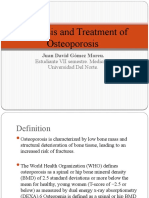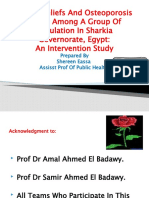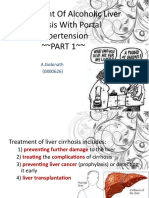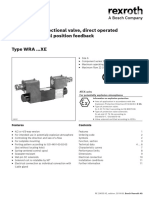Abstractsba2013 Session1 Osteoporosis in Malaysia
Abstractsba2013 Session1 Osteoporosis in Malaysia
Uploaded by
natheCopyright:
Available Formats
Abstractsba2013 Session1 Osteoporosis in Malaysia
Abstractsba2013 Session1 Osteoporosis in Malaysia
Uploaded by
natheCopyright
Available Formats
Share this document
Did you find this document useful?
Is this content inappropriate?
Copyright:
Available Formats
Abstractsba2013 Session1 Osteoporosis in Malaysia
Abstractsba2013 Session1 Osteoporosis in Malaysia
Uploaded by
natheCopyright:
Available Formats
Osteoporosis in Malaysia
Dr LEE Joon Kiong
President, Osteoporosis Awareness Society of Kuala Lumpur
Secretary & Past President, Malaysian Osteoporosis Society
Malaysia
Malaysias total population of 28 million in 2010,
those above 65 years of age is estimated to be 4.7%
Malaysian men are expected to live up to 71 years of
age while women will live up to 77.1 years. The longer
life span is attributed to the improvements in
accessibility to health and medical services
There is no data on the incidence of patients with
osteopenia, osteoporosis as well as incidence of
osteoporosis related vertebral fractures.
Malaysia
The overall incidence of hip fractures was 90 per 100 000
individuals. Overall, 63% of patients presenting with hip
fractures were Chinese, 20% were Malays and Indians
13%
Race and sex-specific incidence data showed that the
incidence was highest among Chinese females (220 per
100 000), followed by Indian females (200 per 100 000)
The age-specific incidence was 500 per 100 000 for
patients above 75 years, compared to 10 per 100 000 in
those between 50 and 54 years
Malaysia
There is still a lack of awareness among health care
providers. The public health program does not include
osteoporosis as one of the high priority conditions.
There is also lack of driving force and support from
Ministry of Health to promote bone health.
Still A Neglected Disease
Health Care System
in Asia
Osteoporosis is not yet
recognized as a major
health problem by the
government
No government public
awareness programs
covering prevention,
diagnosis and
management of
osteoporosis
Clinical Practice
Guideline
Malaysian
Osteoporosis
Society
Risk Factors for Osteoporosis and Fracture
Non-Modifiable
Modifiable
Advancing age
Ethnic group (Oriental &
Caucasian)
Female gender
Premature menopause (< 45 years)
including surgical menopause
Family history of osteoporosis or
fracture in first degree relative
Personal history of fracture as an
adult
Low calcium and/or vitamin D intake
Sedentary lifestyle
Cigarette smoking
Excessive alcohol intake (>3 units/day)
Excessive caffeine intake (>3 drinks/day)
Low body weight (BMI < 19 kg/m
2
)
Estrogen deficiency
Impaired vision
Recurrent falls
Number of DXA machines
per 10,000 population
The generally
recommended number of
DXA per 10 000
population is 0.11 in
Europe.
It is clear that most of the
countries in this audit fall
well below this
recommendation
IOF 3rd Asia-Pacific Regional Meeting Kuala Lumpur (JK Lee)
FRAX
Uploaded FRAX data
among Asian countries
Which FRAX if NO FRAX ?
Interpretation and Use of FRAX
in Clinical Practice
15
Consensus of ISCD/IOF FRAX
Initiatives in Asia-Pacific Region
Australia - Richard Prince
China Mainland - Yan-Ling
Zhao, Wei Yu
Indonesia - Gunawan
Tirtarahardja
Japan - Akira Itabashi
Korea - Soo-Shin Chan
Malaysia - Joon-Kiong Lee
Philippine - Julie Li-Yu
Singapore - Siok-Bee Chionh
Taiwan - Paulo Wu, Derrick
Chan, Keh-Sung Tsai, Chieng
Poon Ung, Rong-Sen Yang,
Sheng-Pin Changlai
UK (IOF) - Eugene McCloskey
USA (ISCD) - Bobo Tanner
Consensus of ISCD/IOF FRAX
Initiatives in Asia-Pacific Region Expert Panel
Kanis, Osteoporos Int 2012;15 Mar
Hip Fractures in Women
>300 per 100,000
200-300 per 100,000
<200 per 100,000
0
200
400
600
A
g
e
-
s
t
a
n
d
a
r
d
i
z
e
d
a
n
n
u
a
l
i
n
c
i
d
e
n
c
e
(
r
a
t
e
/
1
0
0
,
0
0
0
)
Classification of Countries within Asia-Pacific Regions
According to the Population Risk of Hip Fracture
Category of
Risk*
Similar Regions
Very High Taiwan
High Hong Kong Singapore
Medium Australia Japan Korea,
Republic
Malaysia
New Zealand Thailand
Low China Mainland India Indonesia Pakistan
Philippines Sri Lanka Vietnam
Undetermined Bangladesh Bhutan Brunei Cambodia
Laos Korea, DPR Myanmar New Caledonia
Papua New
Guinea
* The category of risk is summarized from the documented data of women aged 50 and above.
USA Asians
FRAX
2.4%
0.4%
Singapore
Malay
FRAX
Hong Kong
FRAX
Clinical Practice
Guideline (2012)
FRAX
The country-specific FRAX prediction algorithms are
available for some countries but not for Malaysia. For
Malaysians, we recommend the use of ethnic specific
algorithms (e.g. Singapore Chinese, Singapore Malay,
Singapore Indian or Hong Kong) until local data is available.
Clinical Practice Guideline (2012) - FRAX
In patients with osteopenia, initiation of treatment is
recommended with a fracture probability of more than 3%
at 10 years for hip or 20% at 10 years for major
osteoporosis related fracture.
If FRAX is not accessible, elderly individuals over 65 years
of age with multiple risk factors who are at sufficiently
high risk for osteoporosis, can be started on treatment.
Clinical Practice Guideline (2012) - FRAX
Post Menopausal
Osteoporosis
Male Osteoporosis
GIOP
Who to treat?
Clinical risk factors?
Presence of low trauma factures?
DXA?
Osteopenia?
Osteoporosis?
Treatments for Osteoporosis
Anti-resorptives
Estrogen progesterone
(Daily)
SERM
Raloxifene (Daily)
Bisphosphonates
Alendronate Plus (Weekly)
Ibandronate (Monthly)
Risedronate (Weekly)
Zoledronate (Yearly)
Biologics
Denosumab (6 monthly)
Anabolic
r-PTH (Daily)
Basic
Calcium and vitamin D
(Daily)
Other
Strontium ranelate
(Daily)
Treatments Available
Clinical Guidance on the
Management of Osteoporosis 2012
Monitoring
Monitoring
Aim: To assess the response to treatment
Clinical Guidance for Mx Osteoporosis 2012 - Chapter 4
1) DXA
2) Bone Turnover markers
Monitoring of treatment
Patients should have regular clinical
assessments
DXA (spine/hip) performed at 1-2 year
intervals, preferably with the same machine
Monitoring with QUS / peripheral DXA is not
recommended
Monitoring of treatment
After starting treatment,
& as indicated
If Bone Turnover Markers are available,
- Baseline : 2 separate measurements of same marker
- Follow-up : 1 repeat measurement
at 2-3 months
at yearly intervals
Measurements should be taken at the same time
of day to minimize effect of diurnal variation
Bone Turnover Markers
Bone Turnover Markers (BTMs) can be used to
evaluate treatment efficacy
28,29,30
Changes in level of BTM can be seen within 3-6
months after initiation of drug therapy
26,27
(Grade B, Level IIa)
26. Lehtonen-Veromaa M, Mttnen T, Irjala K, et al. J Clin Endocrinol Metab 2000;85:372632
27. Kraenzlin ME, Seibel MJ, Trechsel U, et al. Calcif Tissue Int 1996;58:216-20
28 Raisz L, Smith JA, Trahiotis M, et al. Osteoporos Int 2000;11:615-20
29 Seibel MJ, Woitge HW, Farahmand I, et al. Exp Clin Endocrinol Diabetes 1998;106:143-8
30 Delmi M, Rapin CH, Bengoa JM, Delmas PD, Vasey H, Bonjour JP. Lancet 1990;335(8696):1013-6
Table 6: Currently Available Biochemical Markers
Bone Turnover Markers (BTMs)
How long to treat?
It is recommended to evaluate the efficacy of
bisphosphonate therapy after 3-5years
If a lack of efficacy is noted, i.e. significant deterioration
of BMD, or recurrent low trauma fracture occurs, re-
evaluation is required to exclude the following:
Secondary causes of osteoporosis
Drug compliance
If the above have been excluded, bisphosphonates can
either be continued or an alternative therapy can be
considered (i.e. anabolic therapy)
How long to treat?
When prescribing bisphosphonates for longer than 5
years, evaluation of the need for continued
bisphosphonate therapy is recommended.
In patients:
with low risk of fracture, consider a drug holiday
with evidence of atypical femoral shaft fracture,
bisphosphonate therapy should be discontinued
with high risk of fracture, consider continuing bisphosphonate
therapy up to 10 years
Conclusions
Patients with a prior fragility / osteoporotic
fracture, or osteoporosis on DXA measurement,
need to be treated
The therapeutic aim of treatment is to reduce
fractures, rather than just to increase BMD
In the vast majority of cases, the benefit of
treatment outweigh the small risk of adverse
events
THANK YOU
You might also like
- Osteoporosis in Men PDFDocument21 pagesOsteoporosis in Men PDFMihai GabrielaNo ratings yet
- DkaDocument32 pagesDkanatheNo ratings yet
- Assignment WWTD 2Document9 pagesAssignment WWTD 2imranNo ratings yet
- Astrology of AddictionsDocument2 pagesAstrology of Addictionsanu056No ratings yet
- Last Man StandingDocument33 pagesLast Man StandingWolf w (Wolf100044)100% (1)
- ClinicianSGuideToPreventionAnd PDFDocument23 pagesClinicianSGuideToPreventionAnd PDFMadalina Mihaela VasilacheNo ratings yet
- 1 s2.0 S2405525516300048 MainDocument12 pages1 s2.0 S2405525516300048 MainmohamedNo ratings yet
- AdelaideDocument8 pagesAdelaidewidiwwwNo ratings yet
- New Osteo Peros Is GuidelinesDocument20 pagesNew Osteo Peros Is GuidelinesTara WandhitaNo ratings yet
- An Update of The Malaysian Clinical Guidance On The Mana - 2017 - Osteoporosis ADocument7 pagesAn Update of The Malaysian Clinical Guidance On The Mana - 2017 - Osteoporosis ADavid Ruiz GonzalezNo ratings yet
- 198 2014 Article 2940Document15 pages198 2014 Article 2940Kang ChenNo ratings yet
- OsteopeniaDocument9 pagesOsteopeniaMohamed EssallaaNo ratings yet
- 2 Osteoporosis Track 2Document45 pages2 Osteoporosis Track 2dilla putriNo ratings yet
- Osteoporosis - Screening & TestingDocument28 pagesOsteoporosis - Screening & TestingJoseNo ratings yet
- Use of SERMs in MenopauseDocument3 pagesUse of SERMs in MenopausePoonguzhali PratNo ratings yet
- Ostteop. Cadera y ColumnaDocument14 pagesOstteop. Cadera y ColumnaJuan DavidNo ratings yet
- OsteoporosisDocument43 pagesOsteoporosisMuna Hassan Mustafa100% (2)
- Effectiveness of Neuromuscular Taping Application and Combination of Ultrasound Therapy Plus Exercise Therapy Protocol To Reduce Pain and Functional Disability in Elderly With Knee OsteoarthritisDocument6 pagesEffectiveness of Neuromuscular Taping Application and Combination of Ultrasound Therapy Plus Exercise Therapy Protocol To Reduce Pain and Functional Disability in Elderly With Knee OsteoarthritisInternational Journal of Innovative Science and Research TechnologyNo ratings yet
- Reumatology DR - RehabDocument59 pagesReumatology DR - RehabMohammed Saad NabhanNo ratings yet
- 9 Functional Benefits Are Sustained After A Program of Supervised...Document12 pages9 Functional Benefits Are Sustained After A Program of Supervised...Leticia RiveraNo ratings yet
- Osteoporosis Medscape, IncompletoDocument58 pagesOsteoporosis Medscape, IncompletolssucllaNo ratings yet
- CGJ 18 29 PDFDocument6 pagesCGJ 18 29 PDFZenithaMeidaNo ratings yet
- Osteoporosis Is Defined As A Skeletal Disorder Characterized by Compromised BoneDocument7 pagesOsteoporosis Is Defined As A Skeletal Disorder Characterized by Compromised BoneEsther KwanNo ratings yet
- The Optimal Cut-Points For Weight and Non-Weight Quantitative Ultrasound of The Calcaneus To Screen Osteoporosis in Postmenopausal WomenDocument8 pagesThe Optimal Cut-Points For Weight and Non-Weight Quantitative Ultrasound of The Calcaneus To Screen Osteoporosis in Postmenopausal WomensucilestariNo ratings yet
- Treatment of Low Bone Density or Osteoporosis To Prevent Fractures in Men and WomenDocument28 pagesTreatment of Low Bone Density or Osteoporosis To Prevent Fractures in Men and WomenSadia AfrinNo ratings yet
- Complete Summary: Guideline TitleDocument11 pagesComplete Summary: Guideline TitleAndiTiwsNo ratings yet
- Risendronato 150Document7 pagesRisendronato 150Dayis ZambranoNo ratings yet
- Osteoporosis PDFDocument4 pagesOsteoporosis PDFmawarNo ratings yet
- Osteoporosis: Blondina Marpaung Rheumatology Division Internal Department Medical Faculty USU - MedanDocument47 pagesOsteoporosis: Blondina Marpaung Rheumatology Division Internal Department Medical Faculty USU - MedanFadhly SharimanNo ratings yet
- Osteoporosis in Elderly MenDocument5 pagesOsteoporosis in Elderly MenFathia RachmatinaNo ratings yet
- Hot Mud Vs Mustard Pack For OAK - Dr. DushyantDocument7 pagesHot Mud Vs Mustard Pack For OAK - Dr. Dushyantsangu malar selvanNo ratings yet
- 1 s2.0 S8756328215002446 MainDocument10 pages1 s2.0 S8756328215002446 MaindavidNo ratings yet
- Swe Et Al 2016 VibrationTherapy Osteoporosis ReviewArticleDocument9 pagesSwe Et Al 2016 VibrationTherapy Osteoporosis ReviewArticleSkif DakNo ratings yet
- PHAR - Article - 46865 - en - 1 (Untuk Bahan Preventing)Document5 pagesPHAR - Article - 46865 - en - 1 (Untuk Bahan Preventing)Silviani FatmaNo ratings yet
- Op AlgorithmDocument2 pagesOp AlgorithmDR.omaima SheikhNo ratings yet
- Jurnal 1Document3 pagesJurnal 1BrigitaNoviantiNo ratings yet
- Osteoporosis - Quick - Reference - Guide - 2010Document2 pagesOsteoporosis - Quick - Reference - Guide - 2010richiesiteNo ratings yet
- 2017 Guidelines ACP OsteoporosisDocument27 pages2017 Guidelines ACP OsteoporosisSolange Vargas LiclaNo ratings yet
- Jcem 1802Document21 pagesJcem 1802lina gonzalezNo ratings yet
- Osteoporosis DR - ArwaDocument53 pagesOsteoporosis DR - ArwaAbdo OufNo ratings yet
- The Aging of Skeletal Muscle and Potential Therapeutic Effects of Extracts From Edible and Inedible PlantsDocument19 pagesThe Aging of Skeletal Muscle and Potential Therapeutic Effects of Extracts From Edible and Inedible Plantsaaysha guptaNo ratings yet
- 2019 European Guidance For The Diagnosis and Management of Osteoporosis in Postmenopausal Women-1Document42 pages2019 European Guidance For The Diagnosis and Management of Osteoporosis in Postmenopausal Women-1Kelly CaicedoNo ratings yet
- 2018 European Guidance Diagnosis and Management OsteoporosisDocument42 pages2018 European Guidance Diagnosis and Management OsteoporosisManel PopescuNo ratings yet
- Bone Density Testing in General PracticeDocument4 pagesBone Density Testing in General PracticeYooyoPatoNo ratings yet
- Dissertation SynopsisDocument13 pagesDissertation SynopsisUpadhayayAnkurNo ratings yet
- Thesis OsteoporosisDocument8 pagesThesis OsteoporosisRachel Doty100% (2)
- Lluch 2014Document7 pagesLluch 2014mariimaria670No ratings yet
- Slide Bonviva 2Document41 pagesSlide Bonviva 2Maksum PandelimaNo ratings yet
- Vertebral Fracture Risk (VFR) Score For Fracture Prediction in Postmenopausal WomenDocument11 pagesVertebral Fracture Risk (VFR) Score For Fracture Prediction in Postmenopausal WomenAdhiatma DotNo ratings yet
- Epsom SaltDocument48 pagesEpsom SaltSathya Palanisamy100% (1)
- Pharmacologic TX of Primary Osteoporosis or Low Bone Mass To Prevent Fxctures in AdultsDocument18 pagesPharmacologic TX of Primary Osteoporosis or Low Bone Mass To Prevent Fxctures in AdultsErica ValladaresNo ratings yet
- OsteoporosisDocument3 pagesOsteoporosisGheavita Chandra DewiNo ratings yet
- Osteoporosis: A Clinical and Pharmacological UpdateDocument11 pagesOsteoporosis: A Clinical and Pharmacological UpdateherethemindNo ratings yet
- Dops StudyDocument13 pagesDops StudyPriyasha AdhikariNo ratings yet
- Osteoporosis & Its ManagementDocument32 pagesOsteoporosis & Its ManagementCreative mindsNo ratings yet
- Orthopedic May 2013Document11 pagesOrthopedic May 2013javi222222No ratings yet
- Health Believes and OsteoporosisDocument31 pagesHealth Believes and OsteoporosistarikeopsNo ratings yet
- 6 Efficacy and Safety of A Modular Multi-Modal Exercise Program...Document7 pages6 Efficacy and Safety of A Modular Multi-Modal Exercise Program...Leticia RiveraNo ratings yet
- General - OsteoporosisDocument9 pagesGeneral - OsteoporosisAsma NazNo ratings yet
- Zhao 2015Document14 pagesZhao 2015orsk49No ratings yet
- Innes 2018 Evid Based Complement Alternat MedDocument20 pagesInnes 2018 Evid Based Complement Alternat MedtaxialuendaNo ratings yet
- Treatment of Postmenopausal OsteoporosisDocument8 pagesTreatment of Postmenopausal OsteoporosisLaura_Puspita__9294No ratings yet
- 3 - Zoledronic Acid - Drug Information - UpToDateDocument33 pages3 - Zoledronic Acid - Drug Information - UpToDateKellyKKSNo ratings yet
- Complementary and Alternative Medical Lab Testing Part 17: OncologyFrom EverandComplementary and Alternative Medical Lab Testing Part 17: OncologyNo ratings yet
- Audit FinalisedDocument346 pagesAudit FinalisednatheNo ratings yet
- Describe The Use of The Null Hypothesis and P-Value in A Drug TrialDocument2 pagesDescribe The Use of The Null Hypothesis and P-Value in A Drug TrialnatheNo ratings yet
- ECG UndergraduatesDocument18 pagesECG UndergraduatesnatheNo ratings yet
- A Anthology Broughton Ocr Jbig2Document178 pagesA Anthology Broughton Ocr Jbig2snejiNo ratings yet
- Case Write-Ups: Name of Patient, Hospital Number and Diagnosis Signature of Faculty and DateDocument2 pagesCase Write-Ups: Name of Patient, Hospital Number and Diagnosis Signature of Faculty and DatenatheNo ratings yet
- Management of Alcoholic Liver Cirrhosis With Portal Hypertension PART 1Document8 pagesManagement of Alcoholic Liver Cirrhosis With Portal Hypertension PART 1natheNo ratings yet
- Lifern's Anatomy: Limbs & Trunk: Thorax.................................................. 32Document162 pagesLifern's Anatomy: Limbs & Trunk: Thorax.................................................. 32natheNo ratings yet
- Lecture 14 Composite Materials Basic Concepts - 221129 - 114750Document16 pagesLecture 14 Composite Materials Basic Concepts - 221129 - 114750Praveesh KumarNo ratings yet
- Effects of Exercise On Mental and Physical HealthDocument8 pagesEffects of Exercise On Mental and Physical Healthfnf102030No ratings yet
- MR 68 Medical Form April 2018Document2 pagesMR 68 Medical Form April 2018koko zowaideNo ratings yet
- Arogyamrutamu Telugu Ayurvedic BookDocument37 pagesArogyamrutamu Telugu Ayurvedic BookgangarajuNo ratings yet
- Proportional Directional Valve, Direct Operated Without Electrical Position Feedback Type WRA XEDocument12 pagesProportional Directional Valve, Direct Operated Without Electrical Position Feedback Type WRA XEGonzalo LezooNo ratings yet
- 12 - Chemistry QP (Set-I)Document6 pages12 - Chemistry QP (Set-I)Shravan ZoneNo ratings yet
- Screenshot 2023-04-26 at 20.07.32 PDFDocument1 pageScreenshot 2023-04-26 at 20.07.32 PDFBotond VertesNo ratings yet
- 2014 2013 Math, Physics, ChemistryDocument30 pages2014 2013 Math, Physics, ChemistryMolay AdhikaryNo ratings yet
- Mcfit Cyberobics Kursplan 15.05.2017Document2 pagesMcfit Cyberobics Kursplan 15.05.2017Ghita LaousyNo ratings yet
- Sales Spec 11212222 Organic Ginger Juice, Pasteurized - US v5Document1 pageSales Spec 11212222 Organic Ginger Juice, Pasteurized - US v5Germán R ZapsanNo ratings yet
- Kegiatan Tengah Semester (KTS) Ganjil Madrasah Ibtidaiyah Darul Ulum Rejotangan TAHUN PELAJARAN 2019/2020Document3 pagesKegiatan Tengah Semester (KTS) Ganjil Madrasah Ibtidaiyah Darul Ulum Rejotangan TAHUN PELAJARAN 2019/2020mohamad romadonNo ratings yet
- Sapozhnikov 2021 IOP Conf. Ser. Earth Environ. Sci. 640 022048Document10 pagesSapozhnikov 2021 IOP Conf. Ser. Earth Environ. Sci. 640 022048lamegdafefarta38No ratings yet
- 999 325 RevA 2 17 Carriere Motion Elastic Protocols DOM PDFDocument2 pages999 325 RevA 2 17 Carriere Motion Elastic Protocols DOM PDFkatherineNo ratings yet
- Balud Del Sur - DTP FinalDocument23 pagesBalud Del Sur - DTP FinalBarangay Balud del SurNo ratings yet
- MovitaDocument8 pagesMovitaRogelio CandoNo ratings yet
- 1400 Corrupted CovenDocument25 pages1400 Corrupted CovenAsrielNo ratings yet
- Quad Check ValveDocument1 pageQuad Check ValveShimplementheIhoThuRapheroNo ratings yet
- IELTS Speaking Lesson Self ImprovementDocument2 pagesIELTS Speaking Lesson Self ImprovementmkatgramosNo ratings yet
- English Test (Evaluación) 2Document4 pagesEnglish Test (Evaluación) 2sbnnpfwtpdNo ratings yet
- Interface Generac G Panel ModbusDocument1 pageInterface Generac G Panel Modbusbalajiboss005No ratings yet
- Bizhub - c360 Service ManualDocument1,150 pagesBizhub - c360 Service ManualRudyNo ratings yet
- LAN&TAM A320NEO PW Ignition and Starting Systems Student BooksDocument41 pagesLAN&TAM A320NEO PW Ignition and Starting Systems Student Booksanarko arsipelNo ratings yet
- Guidelines For Management of Severe Sepsis and Septic ShockDocument2 pagesGuidelines For Management of Severe Sepsis and Septic ShockasupicuNo ratings yet
- Acute Myocardial InfarctionDocument13 pagesAcute Myocardial InfarctionSajjad KabirNo ratings yet
- Marechal Single Pole Range enDocument30 pagesMarechal Single Pole Range ennikhil prakasNo ratings yet
- Disorders of The Blood and Neoplastic DisordersDocument72 pagesDisorders of The Blood and Neoplastic DisordersavisenicNo ratings yet
- ICC-ES Legacy Report NER-405 (James Hardie Building Products, Inc.)Document35 pagesICC-ES Legacy Report NER-405 (James Hardie Building Products, Inc.)Karma Pema DorjeNo ratings yet

































































































